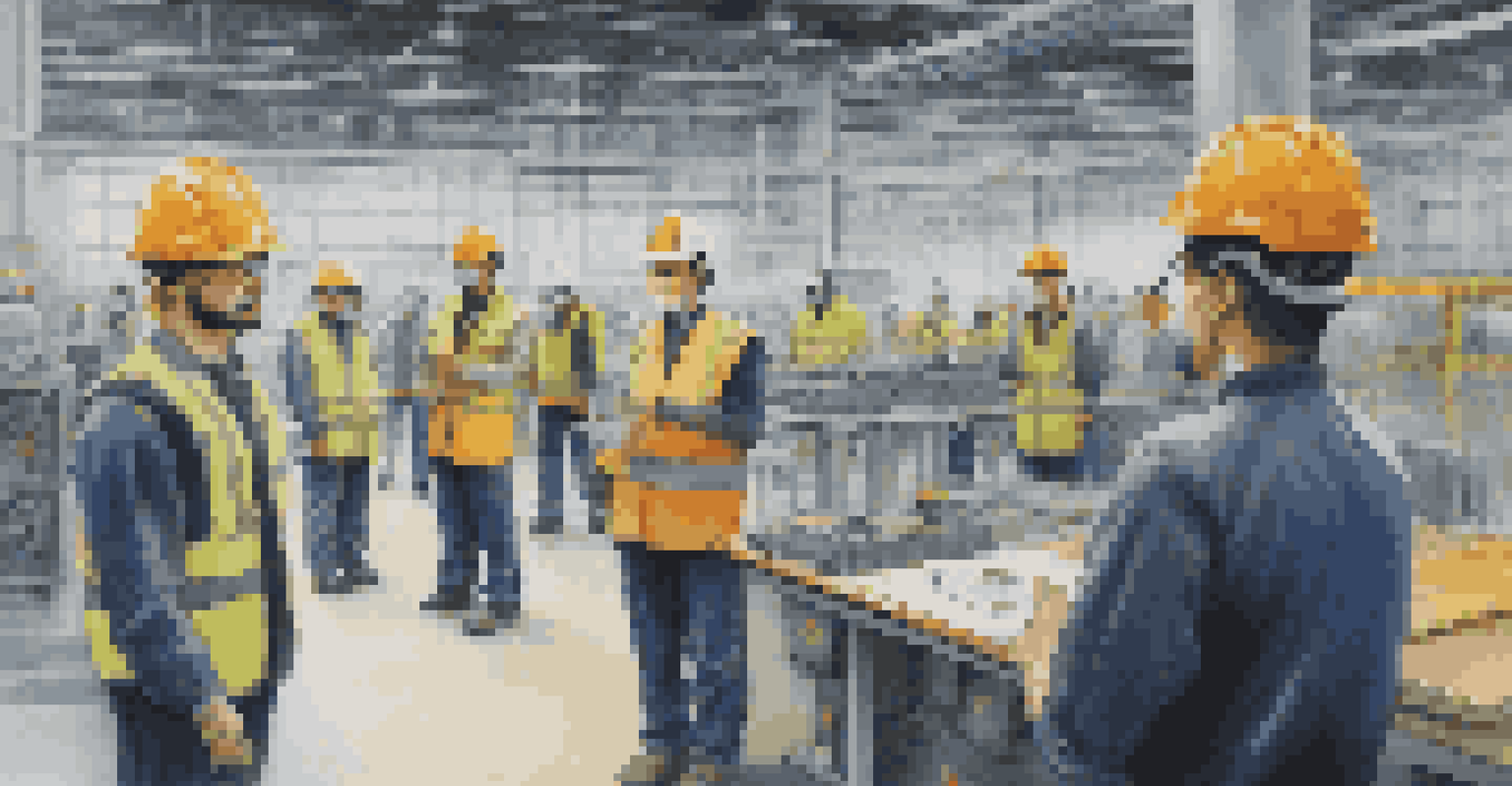The Future of Workplace Safety: Trends and Innovations

The Rise of Technology in Workplace Safety
As we look to the future, technology is transforming workplace safety in unprecedented ways. From wearable devices that monitor employee health to AI systems that predict potential hazards, these innovations are making workplaces safer than ever. For instance, smart helmets equipped with AR can provide real-time data and guidance to workers in hazardous environments.
Safety isn't just a slogan, it's a way of life.
Moreover, the integration of Internet of Things (IoT) devices allows for constant monitoring of equipment and environments. This real-time data collection helps companies identify potential safety risks before they escalate. Imagine a factory where machines can alert operators about malfunctions, reducing the risk of accidents significantly.
These technological advancements not only improve safety but also enhance productivity. With fewer accidents, employees can focus on their tasks without the constant worry of injury. As we embrace these innovations, the future of workplace safety looks promising, paving the way for healthier work environments.
Mental Health: A New Frontier in Workplace Safety
Workplace safety is no longer just about physical hazards; mental health is becoming a critical component. Companies are recognizing that a safe work environment includes supporting employees' mental well-being. This shift is evident as more organizations implement wellness programs and mental health days, fostering a supportive culture.

For example, businesses are now offering resources such as counseling services and stress management workshops. These initiatives not only help employees feel valued but also reduce absenteeism and improve overall morale. Imagine a workplace where employees feel comfortable discussing their mental health without fear of stigma—this is the future we’re heading towards.
Tech Innovations Enhance Safety
Wearable devices and IoT technology are revolutionizing workplace safety by providing real-time monitoring and hazard predictions.
By prioritizing mental health, companies can create a more resilient workforce. When employees feel mentally safe and supported, they are more likely to engage fully with their work. This holistic approach to safety is essential for driving long-term success in any organization.
Emphasis on Ergonomics for Improved Safety
Ergonomics is playing an increasingly important role in workplace safety as organizations strive to prevent injuries related to poor posture and repetitive strain. By designing workspaces that promote proper body mechanics, companies can significantly reduce the risk of musculoskeletal disorders. Think about a factory where assembly lines are tailored to fit workers' heights and reach—this can lead to fewer injuries and higher productivity.
The greatest asset of a company is its people. If people are not safe, the company cannot be successful.
Investing in ergonomic furniture and tools is another trend gaining traction. Adjustable desks, ergonomic chairs, and specialized equipment can make a world of difference in employee comfort. When workers are comfortable, they can focus better and work more efficiently, ultimately benefiting the entire organization.
As we move forward, integrating ergonomic principles into workplace design will be essential. By prioritizing comfort and functionality, businesses can create safer environments that enhance employee well-being and productivity.
Training and Education: Key to Safety Innovations
Effective training and education are crucial in implementing new safety innovations. As technology evolves, so must the skills of the workforce. Companies are now investing in continuous training programs that help employees stay abreast of the latest safety protocols and technologies. For example, virtual reality (VR) training can simulate hazardous situations, allowing employees to practice responses in a safe environment.
Moreover, fostering a culture of safety through regular workshops and seminars can empower employees to take proactive measures in their own safety. When workers are well-informed about potential dangers and the latest safety tools, they are more likely to act responsibly. This proactive approach not only prevents accidents but also creates a community of safety-minded individuals.
Mental Health is Essential
Companies are increasingly recognizing the importance of mental health in workplace safety, implementing wellness programs to support employee well-being.
Ultimately, a well-trained workforce is a safe workforce. By prioritizing ongoing education, companies can ensure that their employees are equipped to handle new technologies and safety challenges effectively.
Regulatory Changes Driving Workplace Safety Forward
Regulatory changes are significantly impacting the landscape of workplace safety. Governments and organizations are continually updating safety standards to reflect new technologies and practices. For instance, recent regulations may require more stringent reporting of workplace incidents or mandate the use of specific safety equipment in particular industries.
These changes compel businesses to adapt and innovate in their safety practices. Organizations that stay ahead of regulatory requirements not only protect their employees but also enhance their reputations. Think of it this way: companies that prioritize compliance are essentially investing in their long-term success and employee well-being.
As regulations evolve, so will the expectations of workers and stakeholders. Companies must be proactive in understanding and implementing these changes to create a safer and more compliant workplace.
The Role of Leadership in Promoting Safety Culture
Leadership plays a pivotal role in fostering a culture of safety within organizations. When leaders prioritize safety, it sets the tone for the entire workforce. This commitment can be demonstrated through regular safety meetings, open discussions about safety concerns, and leading by example in adhering to safety protocols.
For instance, a manager who actively participates in safety training and encourages team members to do the same cultivates a culture where safety is everyone's responsibility. By showing that safety is a core value, leaders can inspire employees to take ownership of their own safety and that of their colleagues.
Leadership Shapes Safety Culture
Strong leadership is crucial for fostering a culture of safety, as leaders who prioritize safety inspire employees to take responsibility for their own safety.
As we look to the future, strong leadership will be essential in maintaining and advancing workplace safety initiatives. Leaders who prioritize safety not only protect their teams but also drive engagement and productivity, creating a win-win scenario for everyone involved.
Sustainability and Safety: A Growing Connection
The connection between sustainability and workplace safety is becoming increasingly evident as companies prioritize eco-friendly practices. Sustainable initiatives often lead to safer work environments, as they frequently involve reducing hazardous materials and improving air quality. For example, using non-toxic materials in manufacturing not only protects the environment but also enhances employee health.
Additionally, sustainable practices can reduce waste and improve the overall efficiency of operations. Companies that adopt green technologies, like energy-efficient machinery, often find that these upgrades also contribute to safer working conditions. Imagine a workplace where less energy consumption leads to a lower risk of electrical hazards—this is the future we’re striving for.

As sustainability becomes a core value for more organizations, it's clear that safety and environmental responsibility go hand in hand. Embracing this connection can lead to a healthier workplace and a more sustainable future for all.
Looking Ahead: The Future of Workplace Safety
As we look to the horizon, the future of workplace safety is filled with exciting possibilities. The integration of advanced technologies, a focus on mental health, and an emphasis on ergonomics are just the beginning. With ongoing innovation and a commitment to safety, organizations can create environments where employees thrive.
Moreover, as society becomes more aware of the importance of safety, we can expect to see a shift in workplace cultures. Companies will increasingly prioritize employee well-being, leading to a more engaged and productive workforce. This transformation will not only benefit employees but also enhance organizational success.
In conclusion, the future of workplace safety is bright, driven by trends and innovations that prioritize the health and safety of every worker. By embracing these changes, organizations can build a safer, more sustainable future that fosters growth and well-being for all.